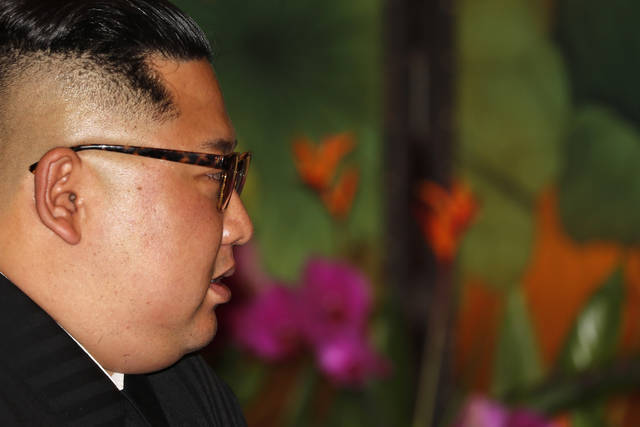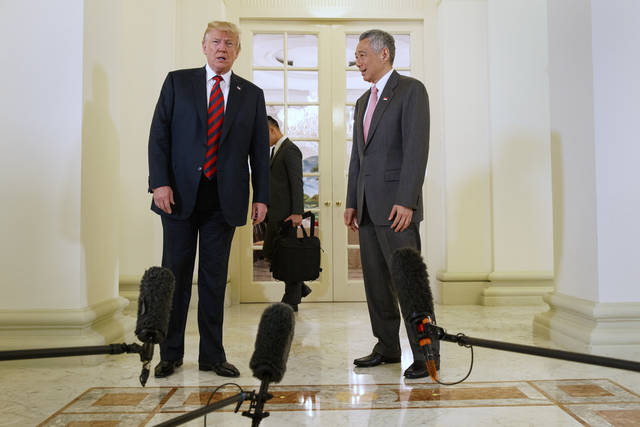SINGAPORE — In the latest twist in the drama-filled nuclear talks with North Korea’s Kim Jong Un, President Donald Trump announced on the eve of their historic meeting that he will be leaving Singapore early because the nuclear negotiations have moved “more quickly than expected.”
That was before the two had even met, and it was not clear whether it was good news or not.
No details were given on any possible progress in preliminary talks between aides at the talks. And the abrupt change in schedule came shortly after U.S. Secretary of State Mike Pompeo had seemed to lower expectations for the meeting, which Trump had earlier predicted could potentially yield an on-the-spot end to the Korean War.
Instead, Pompeo suggested the summit, while historic, might yield little in the way of concrete success other than to pave the way for more meetings in the future.
It will be Trump’s second unexpected early departure from a summit in just a few days.
The sudden change in schedule added to a dizzying few days for foreign policy for Trump, who shocked U.S. allies over the weekend when he used a meeting of the Group of 7 industrialized economies in Canada to alienate America’s closest friends in the West. Lashing out over trade practices, he lobbed insults at the G-7 host, Canadian Prime Minister Justin Trudeau. He left early, and as he flew to Singapore, he tweeted that he was yanking the U.S. out of the traditional group statement.
As Trump was trying to build a bridge with Kim, he was smashing longtime alliances with Western allies with his abrasive performance at the G-7. He continued to tweet angrily at Trudeau from Singapore, saying Monday “Fair Trade is now to be called Fool Trade if it is not Reciprocal.”
Trump advisers cast his actions as a show of strength before the Kim meeting. Economic adviser Larry Kudlow told CBS News in Washington that “Kim must not see American weakness.”
Trump, after the first-ever meeting between U.S. and North Korean leaders, had been scheduled to fly back to Washington on Wednesday morning after spending Tuesday with Kim in Singapore. But on the eve of the summit, he altered his schedule, opting to return at about 8 p.m. on Tuesday after a full day of meetings with Kim — almost 15 hours earlier than previously anticipated.
“The discussions between the United States and North Korea are ongoing and have moved more quickly than expected,” the White House said in a statement.
U.S. and North Korean officials have been holding preliminary meetings in the run-up to the Tuesday summit.
In recent days, Trump had suggested the meeting could last days, potentially even resulting in a nuclear deal. But U.S. officials have since avoided such lofty declarations. Abbreviating the meeting to a single day could make it easier to cast the summit as an early, symbolic opening, rather than a substantive negotiation in which a lack of tangible progress would suggest failure on the part of the negotiators.
The White House said the summit was to kick off at 9 a.m. Tuesday. After greeting each other — an image sure to be devoured around the world — the two leaders planned to sit for a one-on-one meeting that a U.S. official said could last up to two hours, with only translators joining them. The official wasn’t authorized to discuss the plans and insisted on anonymity.
The daylong summit will also include a working lunch and a larger meeting involving aides to both leaders, the White House said. On the U.S. side, Trump was to be joined by Pompeo, chief of staff John Kelly, national security adviser John Bolton and U.S. Ambassador to the Philippines Sung Kim, along with a few others.
After concluding the summit, Trump planned to speak to reporters in Singapore before flying home, the White House said.
On the day before the meeting, weeks of preparations appeared to pick up in pace, with U.S. and North Korean officials meeting throughout the day Monday at a Singapore hotel. The leaders themselves had little to say. Trump forecast a “nice” outcome, while Kim spent the day out of view.
Pompeo, addressing reporters ahead of the summit, said the U.S. was prepared to take action to provide North Korea with “sufficient certainty” that denuclearization “is not something that ends badly for them.”
He would not say whether that included the possibility of withdrawing U.S. troops from the Korean Peninsula, but stressed the context of the discussions was “radically different than ever before.”
“I can only say this,” Pompeo said. “We are prepared to take what will be security assurances that are different, unique, than America’s been willing to provide previously.”
In Singapore, the island city-state hosting the summit, the sense of anticipation was palpable, with people lining spotless streets Monday waving cellphones as Trump headed to meet Singapore’s Prime Minister Lee Hsien Loong. As Trump and Lee sat down for a working lunch at the Istana house, Trump sounded optimistic, telling Lee, “we’ve got a very interesting meeting in particular tomorrow, and I think things can work out very nicely.”
Trump also called the leaders of South Korea and Japan in advance of the summit, Pompeo said. Meanwhile, U.S. and North Korean officials huddled at a hotel Monday ahead of the sit-down aimed at resolving a standoff over Pyongyang’s nuclear arsenal.
Delegates were outlining specific goals for what Trump and Kim should try to accomplish and multiple scenarios for how key issues can be resolved, an official briefed on the discussions said. The meetings also served as an ice breaker of sorts as the teams worked to get better acquainted after decades of minimal U.S.-North Korea contact.
Trump and Kim arrived in Singapore on Sunday, both staying at luxurious and heavily guarded hotels less than half a mile apart, with Trump at the Shangri-La Hotel and Kim at the St. Regis Hotel.
Trump, too, has recently sought to minimize expectations, saying additional meetings may be necessary.
Asked Saturday about his goals, he said: “Well, I think the minimum would be relationship. You would start at least a dialogue, because, you know, as a deal person, I have done very well with deals.”
The North has faced crippling diplomatic and economic sanctions, which began years before Trump’s “maximum pressure” campaign, as it has advanced development of its nuclear and ballistic missile programs.
Experts believe the North is close to being able to target the entire U.S. mainland with its nuclear-armed missiles, and while there’s deep skepticism that Kim will quickly give up those hard-won nukes, there’s also some hope that diplomacy can replace the animosity between the U.S. and the North.
While advisers insist Trump has been reviewing briefing materials, he says his gut instincts will matter most when he gets in the room with Kim. He told reporters, “I will know, just my touch, my feel. That’s what I do.”
———
Associated Press writer Foster Klug contributed to this report.



